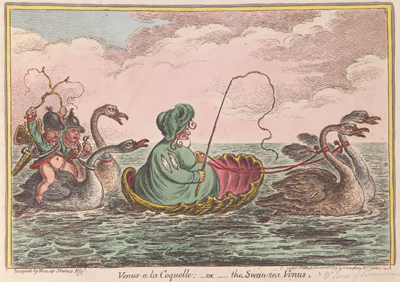Venus a la Coquelle, or the Swan-sea Venus
This rather odd print draws upon three techniques or traditions in caricature: the parody of "serious art," the visual/verbal pun, and the single figure caricature portrait.

© Beinecke Rare Book and Manuscript Library, Yale University
According to Greek mythology, Venus was born fully formed and beautiful arising from the sea on a shell as in Botticelli's famous Birth of Venus. But sometimes her status as a sea-born creature and Goddess of Love was also suggested by representing her driving a chariot across the waters, accompanied by Cupid (or other putti) and drawn by swans.

Venus in a Chariot Drawn by Two Swans
[1544]
©Metroplitian Museum of Art
Gillray's Venus parodies both visual traditions. The famous shell or coquille, so prominent in Botticelli has become a kind of marine curricle, drawn, in the best modern style, by matching swans/steeds. Instead of the sinuous naked beauty famous from classical sculptures, Gillray's Venus is a middle-aged sea-green block of a woman who could hardly be more fully clothed or less like a deity. Her attending cupids are putti-like outriders wearing jockey's caps, and whose unstrung bows have become riding whips.
But though the print mocks high art images of Venus, the punning title ("The Swan-Sea Venus) and the faux-Welsh signature (Shon ap Shones) tell us that this is not like Gillray's earlier Venus Attired by the Graces, (Dec. 8, 1800) a generic parody of a "serious" artistic motif, but a satiric portrait caricature of a particular Welsh woman from Swansea. The other clues to her identity all suggest a woman fond of driving a smart curricle or phaeton accompanied by outriders.
Dorothy George and the British Museum following Thomas Wright, R.H. Evans, and Joseph Grego identify the lady as Mrs. Jones, "a celebrated whip, frequently seen in Hyde Park." But in a recent email to me Clive Towse has provided a convincing and more complete identification of the Swan-Sea Venus. An edited version of his email follows.
I believe she is Sarah Webber born in 1768 and married in 1795 to Arthur Jones, originally from Caervallack, Flintshire. He inherited Priory Reigate from his mother Ann Jones, and moved to Bryn-Newydd near Swansea in the early 1800s. He seems to have sold the Reigate property in 1801. In 1813 he is listed as living at Hill House, but the obituaries of both he and his wife Sarah list their residence as Bryn Newyyd. There is a pedigree of the Webber family in Burke's Family Records pp 622-623. It shows the strong London associations of her father William Webber. Their daughter (also Sarah) became the mother of Henry Hussey Vivian ennobled in 1893 as Baron Swansea. Portraits of Arthur Jones and his wife painted in the style of George Romney are held by Swansea University.
As a portrait caricature, the print is unusually satiric because the reference to Venus cuts both ways. High art is satirized because it is seen as exaggerated and unreal; Sarah Jones is satirized by because she fails to match our expectations of the beauty of Venus. In that context, the broken bows of her Cupid outriders may suggest that there will be no more arrows of desire shot on her behalf.
Sources and Reading
- Commentary from the British Museum on Venus a la Coquelle, or the Swan-sea Venus.
- "Aphrodite," Wikipedia
- "Webber," Burke's Family Records p. 622.
- "History," Reigate Priory Junior School
- A Description of Swansea and its Environs (1813) p. 42.
- "Death Notice: Sarah Jones," Gentleman's Magazine (1850) p. 230
- "Death Notice: Arthur Jones," Gentleman's Magazine (1843)
- Stephen Hughes, Copperopolis: Landscapes of the Early Industrial Period in Swansea, (2000), p. 221
- Thomas Wright and R.H. Evans, Historical and Descriptive Account of the Caricatures of James Gillray #566.
- Thomas Wright and Joseph Grego, The Works of James Gillray, the Caricaturist; With the History of His Life and Times, p. 368.
Comments & Corrections
NOTE: Comments and/or corrections are always appreciated. To make that easier, I have included a form below that you can use. I promise never to share any of the info provided without your express permission.